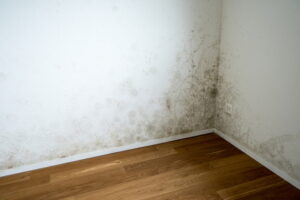We understand if you don’t want to get a closer look at mold. Mold can be quite unpleasant (although we can thank it for some major medical advances like penicillin). But mold is a fact of life that many homeowners and business owners must deal with at times. High humidity, water leaks, damage from flooding, and other problems can cause mold infestations.
We want to help our clients better understand mold problems. In this post, we’re going to look at some facts about mold growth and mold damage and important facts you may not know about them.
Mold can seriously damage your house
Mold isn’t something that just sits on the surface of construction material like an oil stain. Mold eats away at wood and drywall—in fact, drywall is extremely susceptible to mold chewing right through it. Given enough time, mold can cause rot and decay to the structure of your house, leading to expensive repair work. In some cases, a home may need partial renovations to correct the damage mold can create.
Mold is sometimes a health problem
Mold is ugly and it causes damage to building materials. It can do even worse than that, however, as some types of mold are dangerous and can harm a home’s indoor air quality. For example, the molds Stachybotrys and Aspergillus can release mycotoxins, and if people are exposed to them they can suffer from serious illnesses. This can become particularly bad if these molds develop in the HVAC system of a house (a common area of mold to grow) where their toxic spores can easily spread through the ducts to the rooms.
Mold can be hard to see
This is one of the biggest problems with mold: it can hide out of sight and be practically invisible. Mold tends to grow in dark and damp places, such as behind walls and under the floors. One spot mold can often grow without notice is behind bathtubs and showers. Mold growth in these areas can get so bad that it calls for a full bathroom renovation just to get rid of it. Your best guide to finding this mold is with your nose: follow the musty odor. You may also spot bits of discoloration or stains on the walls and ceilings.
Mold often requires remediation, not just cleaning
If you see mold in your house, what can you do about it? Grab some cleaning supplies and wipe it up? That can work with small, minor spots of mold. But mold is often insidious and hard to eliminate with standard cleaning methods. The trouble is that mold spreads rapidly through spores, and just cleaning up mold can cause it to spread. Mold also gets deep into building materials, infiltrating areas you can’t see, as we’ve mentioned above. This is why large mold problems require professional mold remediation where experts use special equipment and techniques to completely remove mold and prevent it from spreading at the same time.
If you have a mold issue in your house, call us to consult about mold remediation in Orange County, CA. We offer a 5-year warranty and free inspections during business hours. All our employees are IICRC-certified and skilled in mold cleanup and repair.
For comprehensive home restoration services you can rely on, contact Jarvis Restoration today!

